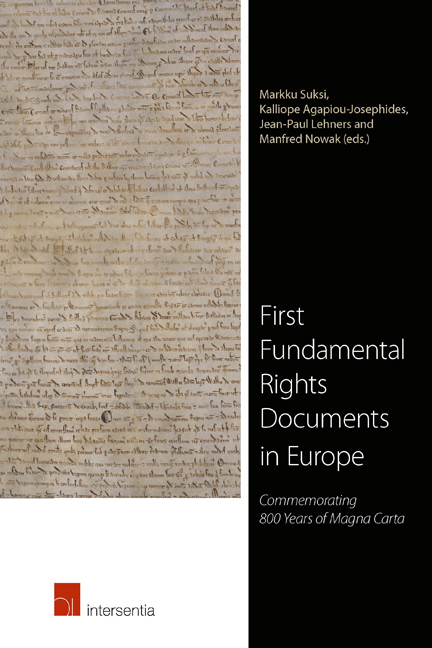Book contents
- Frontmatter
- Preface
- Contents
- List of Authors
- 1 Introduction
- PART I
- PART II
- 11 France: Foundational Importance of the Declaration of 1789
- 12 Sweden: Free Press as a First Fundamental Right
- 13 The Netherlands: The Batavian Staatsregeling as the First Fundamental Rights Document
- 14 Portugal: ‘Tropical Versailles’ in the Beginning of the Nineteenth Century
- 15 Luxembourg: Fundamental Rights in a Small State
- 16 Greece: Reflections from the Hellenic Legal Tradition
- 17 Denmark: In Love with Tradition
- 18 Germany: Fundamental Rights as an Instrument Towards the Rechtstaat
- 19 The Czech Republic: On the Road to Rights and Freedoms
- 20 Romania: The Birth of Fundamental Rights as a Form of Political Contention
- 21 Bulgaria: The Liberal Tarnovo Constitution
- 22 Finland: Rights to Facilitate Participation
- 23 Estonia: First Landmarks of Fundamental Rights
- 24 Slovakia: The Right of a Nation
- 25 Latvia: Second Part of the Constitution as a Project for Next Generations
- 26 The History of Fundamental Rights in Europe: A Long and Winding Road
- Index
17 - Denmark: In Love with Tradition
from PART II
Published online by Cambridge University Press: 15 December 2017
- Frontmatter
- Preface
- Contents
- List of Authors
- 1 Introduction
- PART I
- PART II
- 11 France: Foundational Importance of the Declaration of 1789
- 12 Sweden: Free Press as a First Fundamental Right
- 13 The Netherlands: The Batavian Staatsregeling as the First Fundamental Rights Document
- 14 Portugal: ‘Tropical Versailles’ in the Beginning of the Nineteenth Century
- 15 Luxembourg: Fundamental Rights in a Small State
- 16 Greece: Reflections from the Hellenic Legal Tradition
- 17 Denmark: In Love with Tradition
- 18 Germany: Fundamental Rights as an Instrument Towards the Rechtstaat
- 19 The Czech Republic: On the Road to Rights and Freedoms
- 20 Romania: The Birth of Fundamental Rights as a Form of Political Contention
- 21 Bulgaria: The Liberal Tarnovo Constitution
- 22 Finland: Rights to Facilitate Participation
- 23 Estonia: First Landmarks of Fundamental Rights
- 24 Slovakia: The Right of a Nation
- 25 Latvia: Second Part of the Constitution as a Project for Next Generations
- 26 The History of Fundamental Rights in Europe: A Long and Winding Road
- Index
Summary
INTRODUCTION
On leaving Copenhagen Central Station, the visitor to Denmark will see a 20-meter tall obelisk taking up a prominent position in the station square. This column has traditionally been named the ‘Danes’ symbol of liberty’, ‘a symbol of national cohesion’, or ‘a foundation stone of democracy’. Officially it is called the Liberty Column.
The foundation stone for the Liberty Column was laid by the Crown Prince in 1792, and was a gift from the citizens of Copenhagen to commemorate the abolishment of adscription of the peasants (i.e., feudalism) in 1788 and the agricultural reforms that followed.
The inscriptions of the column read that the King realised that ‘freedom for his citizens laid down by just law’ gives birth to ‘love of the Fatherland, courage to protect it, a zest for knowledge, a desire for industrious work’. The King decreed that adscription should be abolished so that the peasant might be ‘enlightened’, ‘hard-working and good’, and ‘an honest citizen’.
The perception that the abolition of adscription in 1788 was the stepping stone to democracy has transmitted to modern times. Thus it was in accordance with celebrated tradition that the Danish queen in 1988, on the occasion of the celebration of the 200th anniversary of the abolition of adscription, in a speech said that ‘With the Act of 20 June 1788 the foundation was laid, not only for freeing the farmers but also for our society today’.
Can we conclude, then, that the Act of 20 June 1788 abolishing adscription is the first Danish fundamental rights document? On closer inspection, this conclusion calls for qualification. First of all, there are earlier documents in Danish history which contain substantial and fundamental rights, albeit only relevant to a few segments of society. This applies most notably to the Coronation Charter of 1282, issued by King Erik Klipping. This charter, which in some ways is the Danish parallel to Magna Carta, was the result of severe clashes between King Erik Klipping and the noblemen of the country caused by the king's abuse of power.3 Thus he had used his judicial power to execute disobedient and difficult subjects, typically noblemen, for lese-majesty, and to take over their property.
- Type
- Chapter
- Information
- First Fundamental Rights Documents in EuropeCommemorating 800 Years of Magna Carta, pp. 209 - 220Publisher: IntersentiaPrint publication year: 2015



